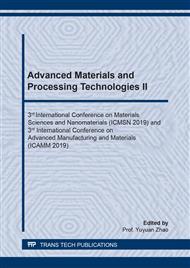[1]
M. E. Abdullah et al., A Review on The Exploration of Nanomaterials Application in Pavement Engineering,, J. Teknol., vol. 73, no. 4, Mar. (2015).
Google Scholar
[2]
G. Shafabakhsh, S. M. Mirabdolazimi, and M. Sadeghnejad, Evaluation the effect of nano-TiO2 on the rutting and fatigue behavior of asphalt mixtures,, Constr. Build. Mater., vol. 54, p.566–571, Mar. (2014).
DOI: 10.1016/j.conbuildmat.2013.12.064
Google Scholar
[3]
M. El-Shafie, I. M. Ibrahim, and A. M. M. Abd El Rahman, The addition effects of macro and nano clay on the performance of asphalt binder,, Egypt. J. Pet., vol. 21, no. 2, p.149–154, Dec. (2012).
DOI: 10.1016/j.ejpe.2012.11.008
Google Scholar
[4]
H. Yao, Q. Dai, Z. You, M. Ye, and Y. K. Yap, Rheological properties, low-temperature cracking resistance, and optical performance of exfoliated graphite nanoplatelets modified asphalt binder,, Constr. Build. Mater., vol. 113, p.988–996, Jun. (2016).
DOI: 10.1016/j.conbuildmat.2016.03.152
Google Scholar
[5]
H. Zhang, M. Su, S. Zhao, Y. Zhang, and Z. Zhang, High and low temperature properties of nano-particles/polymer modified asphalt,, Constr. Build. Mater., vol. 114, p.323–332, Jul. (2016).
DOI: 10.1016/j.conbuildmat.2016.03.118
Google Scholar
[6]
A. A. Mamun and M. Arifuzzaman, Nano-scale moisture damage evaluation of carbon nanotube-modified asphalt,, Constr. Build. Mater., vol. 193, p.268–275, Dec. (2018).
DOI: 10.1016/j.conbuildmat.2018.10.155
Google Scholar
[7]
A. A. Mamun and H. I. Al-Abdul Wahhab, Comparative laboratory evaluation of waste cooking oil rejuvenated asphalt concrete mixtures for high contents of reclaimed asphalt pavement,, Int. J. Pavement Eng., p.1–12, Nov. (2018).
DOI: 10.1080/10298436.2018.1539486
Google Scholar
[8]
A. A. Mamun and H. I. Al-Abdul Wahhab, Evaluation of Waste Engine Oil-Rejuvenated Asphalt Concrete Mixtures with High RAP Content,, Adv. Mater. Sci. Eng., vol. 2018, p.1–8, Dec. (2018).
DOI: 10.1155/2018/7386256
Google Scholar
[9]
M. Arifuzzaman, Nano-scale evaluation of moisture damage in asphalt,, Civ. Eng. ETDs, Feb. (2011).
Google Scholar
[10]
M. R. Hassan, A. A. Mamun, M. I. Hossain, and M. Arifuzzaman, Moisture Damage Modeling in Lime and Chemically Modified Asphalt at Nanolevel Using Ensemble Computational Intelligence,, Comput. Intell. Neurosci., vol. 2018, p.1–9, Apr. (2018).
DOI: 10.1155/2018/7525789
Google Scholar
[11]
U. Gazder, M. Arifuzzaman, U. Shahid, and A. A. Mamun, Effect of fly ash and lime as mineral filler in asphalt concrete,, in Advances in Materials and Pavement Performance Prediction, CRC Press, 2018, p.373–377.
DOI: 10.1201/9780429457791-71
Google Scholar
[12]
A. Mamun, M. Arifuzzaman, and R Taha, Nano scale aging characterization of carbon nanotube modified asphalt binders,, in In Proceedings of Advances in Materials and Pavement Prediction: Papers from the International Conference on Advances in Materials and Pavement Performance Prediction, 2018, p.403.
DOI: 10.1201/9780429457791-96
Google Scholar


